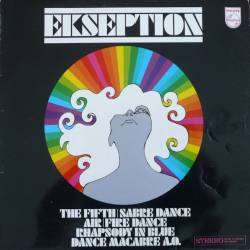Record Details
| Artist: | Ekseption |
|---|---|
| Title: | Ekseption |
| Format: | 12" |
| Label: | Philips |
| Cat No: | 873 003 UBY |
| Released: | 1969 |
| Country: | |
| Genres: | Prog RockJazz-Rock |
| Numbered: | #282 |
| Status | Have |
| Added To List | 28th August 2020 |

×
Disc 1 | 12"
 |
No Notes | |
|
A Matrix: A1 The 5th Arranged By – Ekseption Written-By – L. v. Beethoven* 3:22 A2 Dharma (For One) Written-By – C. Bunker*, I. Anderson* 3:25 A3 Little X Plus Written-By – Ekseption 2:20 A4 Sabre Dance Written-By – A. Khatchaturian* 3:48 A5 Air Arranged By – Ekseption Written-By – J.S. Bach* 2:50 |
||
|
B Matrix: B1 Ritual Fire Dance Written-By – M. De Falla* 3:55 B2 Rhapsody In Blue Written-By – G. Gershwin* 4:00 B3 This Here Written-By – B. Timmons*, J. Hendricks* 4:17 B4 Dance Macabre Opus 40 Written-By – Saint-Saëns* 5:05 B5 Canvas Written-By – B. Bennet* 2:27 |
||





 MyRecordList is free to use - we don't want useless advertising taking up space and the only annoying message you will see on this site is this note asking you to kindly donate whatever you can afford if you use the site regularly or would just like to support a small independent project created for the love of music and record collections.
MyRecordList is free to use - we don't want useless advertising taking up space and the only annoying message you will see on this site is this note asking you to kindly donate whatever you can afford if you use the site regularly or would just like to support a small independent project created for the love of music and record collections.